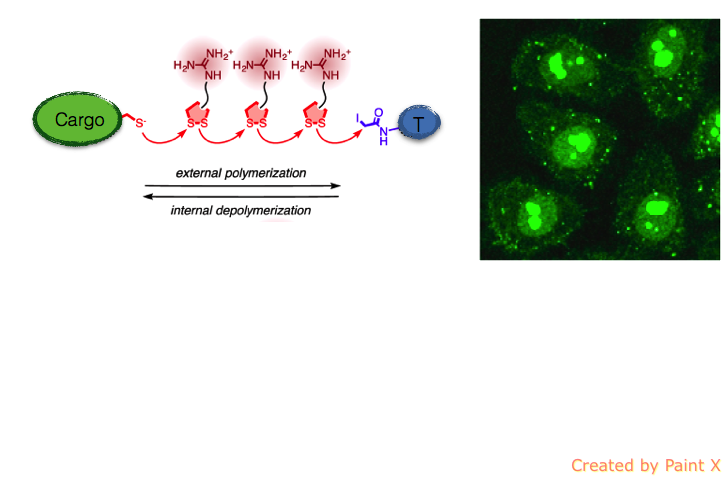Cell-Penetrating Poly(disulfide)s
Substrate-initiated cell-penetrating poly(disulfide)s (si-CPDs) are emerging as innovative molecular transporters due to their ability to deliver cargoes without cytotoxicity, through a proposed novel counterion thiol-mediated uptake mechanism [1]. Inspired by surface-initiated polymerization, we developed a conceptually new approach to grow CPDs on a variety of substrates through ring-opening disulfide exchange polymerization, in solution and under mild conditions. Thiolated fluorescent probes are commonly used as initiators, cyclic disulfides as monomers and iodoacetamides are used as terminators. Like cell-penetrating peptides (CPPs), CPDs are enriched with guanidinium groups which help the delivery of the cargo through the formation of micellar pores in the membrane. However, CPDs also contain a poly(disulfide) backbone which, through dynamic covalent disulfide-exchange, helps to increase uptake and, most importantly, eliminates the cytotoxicity which is common to many CPPs. Due to this dual uptake mechanism, our best performing CPDs were able to reach the nucleus of HeLa cells in 15 minutes and at nM concentration. Once internalized, the poly(disulfide)s are readily depolymerized thanks to the high concentration of glutathione in the cytosol. Recently, CPDs were used to achieve protein delivery through biotin-streptavidin technology [2], leading to the development of a general method to deliver other types of cargoes such as monobodies. CPD sidechain functionalization [3] is used to introduce more solubilizing groups such as sugars is currently undergoing to prevent aggregation during protein delivery.

[1] G. Gasparini, E.-K. Bang, G. Molinard, D. Tulumello, S. Ward, A. Roux, N. Sakai, S. Matile, J. Am. Chem. Soc. 2014, 136, 5575-5578.
[2] G. Gasparini, S. Matile, Chem. Comm. 2015, 51, 17160-17162.
[3] P. Morelli, S. Matile, Helv. Chim. Acta. 2017, 100, e1600370.